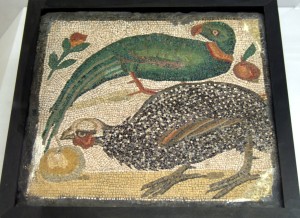First Greek Encounter with a Parrot December 30, 2010
Author: Beach Combing | in : Ancient , trackback
In the ancient Mediterranean parrots were an exotic bird. They were rare, they were multicoloured and they could even repeat human words more convincingly than the native mimics: starlings, magpies and nightingales. Understandably, then, when they appeared, they were attention-grabbers. Indeed, in some periods of antiquity Beachcombing can barely read a source without tripping over one of the infernal rainbow-coloured squawkers.
So Ovid wrote some doggerel for a parrot, a Greek poet Eubulus described a bizarre feast that included parrot meat, Clement of Alexandria berated his congregation for keeping parrots (as well as peacocks and baboons..), one late Roman (Ammianus Marcellinus, Beachcombing’s memory may be at fault?) (Olympidorus of Thebes – thanks Ostrich!) had a pet parrot, nineteenth-century excavators found an Athenian tomb where a young boy was buried with a parrot (a beloved friend?), while poor Statius lost it describing a parrot’s death:
the parrot, the glory and the pride of the fowls of the air, the radiant Ruler of the East, is dead, is dead. Whom neither the bird of Juno with jewelled plumage, nor the denizen of frozen Phasis, nor the Meleagrides, the prey of the Numidians in the rainy south, could surpass in beauty.
But what was the first western contact with this tropical bird? Well, the first recorded encounter almost certainly belongs to Beachcombing’s old friend Ctesias of Cnidus and dates to the late fifth century BC. Ctesias, it will be remembered, was working in Persia as a court doctor. It was in this role that he must have come across the bird and, lo, a Greek found himself staring at one of nature’s most extraordinary works, in this case likely imported into Iran from India.
The parrot is about as large as a hawk, which has a human tongue and voice, a dark red beak, a black beard, and blue feathers up to the neck, which is red like cinnabar. It speaks Indian like a native, and if taught Greek, speaks Greek.
These words are not those – sadly – that Ctesias wrote for Ctesias’ works are, for the most part, lost. Instead, this is a summary made by the untrustworthy Photius (hiss, boo).
Still there is enough to allow some artful speculation as to just what kind of parrot Ctesias had come across. Twenty years ago Joan Bigwood suggested that Ctesias’ Greek had been mangled preferring a different colour scheme: ‘it is the size of a hawk and its face is dark red [purple]. It has a black beard and is blue as far as its neck [i.e. the back of the head is blue]. But on its shoulder it is red like cinnabar.’ On the basis of this she deduced that the bird in question was the male plum-headed parakeet (psittacula cyanocephala).
Beachcombing has no parrot expertise so he is going to take this on trust.
Ctesias’ final comments on the parrot’s verbal talents is more shock than science: of course, parrots cannot speak any language like a native. Six hundred years later Apuleius would be far more blasé. Talking, in his Florida, of the problem of parrots swearing he suggested that the solution was to cut their tongue out…
Beachcombing is always interested in bizarre parrot stories:drbeachcombing AT yahoo DOT com
***
7 March 2011: Judith aka Zenobia has just sent this fabulous picture of parrots drawing a chariot over – or are they partridges? Thanks Judith! (4 April 2011 Judith has no patience with the partridge theory – she writes back pointing to the ‘red beaks and red-flecked, blue/black lined wings’ She may be right…)



